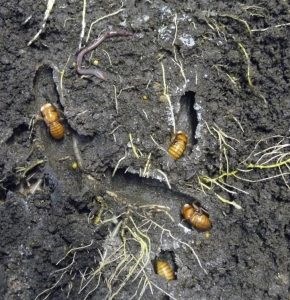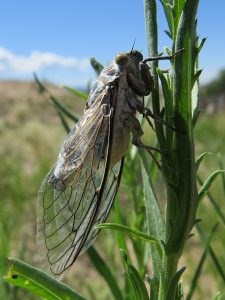This content was originally published by the Longmont Observer and is licensed under a Creative Commons license.
As we approach the dog days of summer, there is a buzz about town. Specifically, the buzz of the cicadas, some of which are actually called dog-day cicadas. The ancient Chinese considered cicadas to be powerful symbols of rebirth. Since I didn’t know very much about these insects, I thought it might be a good time to do some research and share what I found out with you.
Cicadas are actually pretty large insects, generally one to two inches long. They are part of the same family as other insects that feed on sap, such as aphids and leafhoppers. Colorado is home to 26 native species of cicadas. The most common of these are the Putnam’s cicada, the dog day cicada, the mountain cicada, and the cactus dodger cicada. The cicadas you are most likely to hear in Longmont include the Putnam’s cicada and the dog day cicada.
Dog day cicadas can be a little more than two inches long. They are green and white with transparent wings and a blocky body. They are commonly found in cottonwoods and maples. Putnam’s cicada is a black insect with orange highlights, and is commonly found throughout Colorado on honey locust, crabapple, and maple trees. Both species have large, compound eyes.

Female cicadas create a groove in a tree or plant limb and deposit rice-shaped eggs. The groove the eggs are laid in serves two purposes. First, it provides shelter for the eggs and for the young once they hatch. Second, the groove exposes the tree sap to the young which they feed on as they grow. The act of laying eggs in tree branches can kill small branches. Cicadas are called nymphs once they hatch. Eventually, as the cicada nymph matures, it crawls from the groove and drops to the ground. At this point, it will dig with its strong front legs into the ground to find roots to feed on. The act of feeding on roots usually doesn’t damage the plant. Cicadas will stay underground for up to 17 years, depending on the species. Colorado is not home to the cicada species that emerges every 17 years. Instead, we have the type of cicadas that emerge every two to five years.
At the end of the two to five-year cycle, the cicada nymphs emerge from the ground to continue growing into the adult stage. The emerged nymphs will climb a tree and shed their exoskeleton. At this point, blood flows into the wings and inflates them and the new skin begins to harden. Cicadas are adults at this stage and are called imagoes. At the adult stage, cicadas only live for four to six weeks.

Adults will spend most of their time in trees looking for mates. Males will “sing” to the females. Actually, only the males will sing, but both males and females have the organs that allows them to make the noises. Most cicadas have a pair of what are called a tymbals on the sides of their abdomen which are dome-shaped, drum-like organs. By contracting and releasing their abdominal muscles, cicadas are able to make sounds that are further amplified by their mostly hollow abdomen. In fact, the abdomen contains a large air sac that acts like an echo chamber to amplify the sound made by the tymbals. The tymbals also act as an ear so that the cicadas can hear each other. Some cicadas lack the tymbals and make sounds instead by clicking their wings together.
Cicadas are preyed upon by cicada killer wasps and cedar beetles. To escape detection by predators, cicadas use camouflage. The patterns on their bodies and wings help to break up their outlines on trees, and their wings are anti-reflective. Cicada killer wasps look like large yellowjackets and attack adult cicadas. On the other hand, the cedar beetle preys on the nymphs.
You are not very likely to be able to actually see a cicada because they are so well camouflaged, but you will definitely be able to hear them. Dog day cicadas have a song that is a high-pitched whine reminiscent of a buzz saw which lasts for about 15 seconds. Putnam’s cicadas have more of a clicking type sound. Based on these two sounds, you should be able to distinguish between the two types of cicadas. Enjoy the sounds of the dog days of summer!


